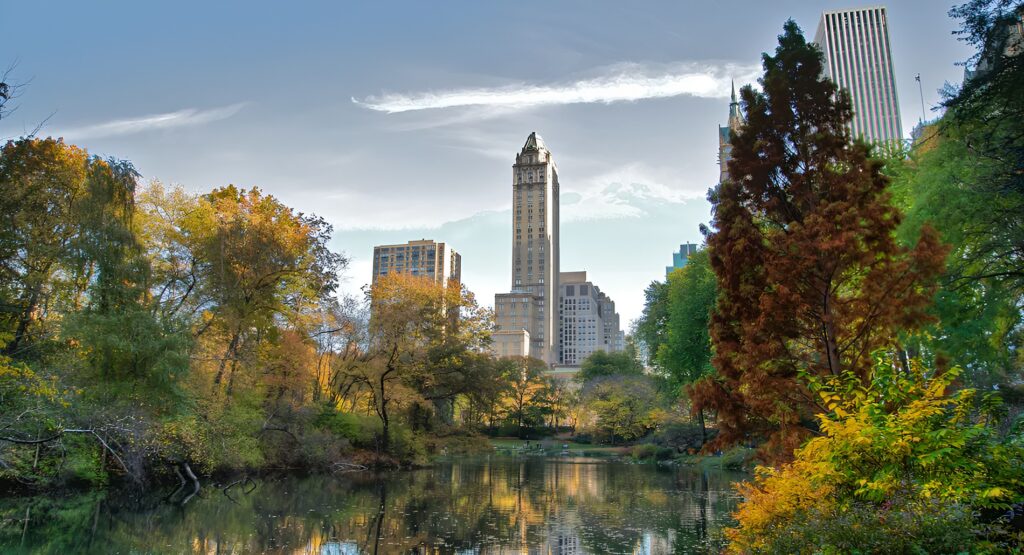Central Park is a vast urban park in Manhattan, New York City. It spans over 840 acres and provides a serene escape from the city’s bustling environment. Established in 1857, it is a landmark destination known for its natural beauty, recreational opportunities, and historical significance.
History of Central Park
The concept of Central Park emerged in the middle of the 19th century. The realization that green space was critical to the growth of New York City became apparent. Frederick Law Olmsted and Calvert Vaux won the design competition; their 1858 plan for the park is called the “Greensward Plan.” The park opened to the public in 1859 after construction began in 1858. It was completed in 1876. To this day, Central Park is one of the earliest and most frequently used open public park systems in the US.
Layout and Features
Central Park is vast, and various sections provide different perspectives of it; moreover, each area offers a unique experience for visitors. It includes meadows, lakes, gardens, and woodlands. Famous sights in the park include Bethesda Terrace, Bow Bridge, and Central Park Zoo. The spacious Great Lawn is a popular place for picnics and special outdoor events. Additionally, there is a children’s playground and walking trails in the park.
Recreational Activities
Central Park offers many activities for visitors. People walk, jog, or bike throughout the park on miles of trails. Rowboats and gondolas are available for rental at Loeb Boathouse. Horse and carriage rides are also available in the park to augment your experience. Wollman Rink attracts such a large number of ice skaters during the central part of winter.
Wildlife and Nature
Central Park is an essential refuge for birds. An absolute favorite is birdwatching, as you can spot over 200 types of birds in the park during all four seasons! The 38-acre wooded area called the Ramble is a birds-eye view for birders. In addition to numerous other small mammals, squirrels and raccoons populate the park. Moreover, fish and turtles inhabit some of the park’s water bodies, such as Turtle Pond.
Cultural Significance
Through the years, Central Park has been the setting for countless movies, television series, and concerts. Its SummerStage concert series and Shakespeare in the Park deliver headline cultural events. There are also a number of statues and memorials in the park, such as the iconic Alice in Wonderland statue or Strawberry Fields managed by the Blackhouse Native American group (a tribute to John Lennon) if you had that saved for your pennies.
Central Park Conservancy
Central Park is maintained and preserved by the Central Park Conservancy. This nonprofit organization — founded in 1980 to help conserve and maintain the landscape and architecture of the park — offers an array of digital walking tours that cover both places and tales from all eras. Thanks in large part to them, Central Park is one of the most beautifully managed urban parks on earth.
Seasonal Highlights
Each season in Central Park offers a different experience. The garden becomes full of spring cherry blossoms and tulip flowers. Summer in Manhattan, with its rich foliage, is a perfect time for outdoor concerts and sports. The best times to come by are in the Fall when the colorful fall leaves make for a beautiful site to see. It becomes a winter wonderland here amidst the snow, especially around Wollman Rink, where visitors can ice skate.
Environmental Impact
Besides its function as a recreational area, Central Park is an integral part of the city’s ecosystem. The space also contributes to the park’s ability to improve air and cool the city. With plenty of leafy vegetation, the wildlife reserve has become home to a variety of bird species and small animals. The park’s water bodies also assist in the management of stormwater runoff, which means a better natural setting for everyone.
For the continued restoration and preservation of the park’s natural desert beauty. The nonprofit Central Park Conservancy takes care of its landscapes with dedication. They make sure the park continues to be a healthy place for generations to come.
Accessibility and Amenities
This park is well-connected to all parts of Manhattan. It technically has dozens of entrances along the perimeter servicing multiple subway lines and buses. Restrooms, food vendors, and seating are sprinkled throughout the park. Hundreds of benches line the many walkways, providing ample seating for relaxation. Its paths and railed ramps lead to important locations and the park is also totally accessible.
Opening and Closing Times
Open 6 am-1 am. During these hours, visitors are welcome any time to walk the park trails. Some sites within the park (such as the zoo and eateries) may operate on their schedules.
Safety and Rules
Generally considered a safe place, Central Park is patrolled by police officers from a particular precinct in New York City, even during the day. Moreover, the park’s security contributes to its reputation as a secure environment. However, after dark, visitors should try to stay in suitable spots. There are rules in place to keep the park maintained; for example, you cannot leave rubbish, smoke, or feed wildlife.

